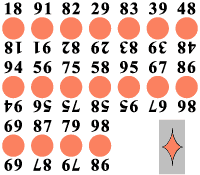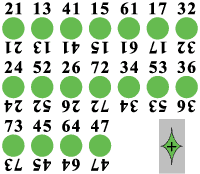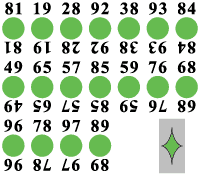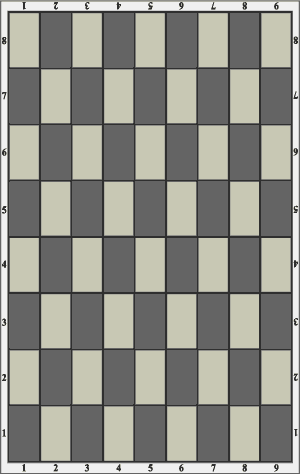|
The first deck of numerical cards.
First part.
Set of seven-symbol numbers with daggers on backs.

Second part.

The second deck of numerical cards.
First part.
Set of seven-symbol numbers with daggers on backs.

Second part.

Game board for chess numerical cards.
72 squares are sufficient for two decks of playing cards in
the version of game with inverse numbers.
 |
Description of inverse gaming version.
Mathematical cards with numbers.
The version with inverse numbers within the
present mathematical gaming contains two decks of 36 numerical playing cards
in each. In aggregate 72 playing cards in two decks possess
inverse numbers. For example, in the first deck there is the num 12 and in the second deck there is
the num 21 which are inverse numbers. Namely numbers 12 and 21 are
inverse each other.
Among two-digit numerical signs there are 72 inverse numbers which are
listed in the beginning of this page, and which form two proportional
groups in two decks. Namely inverse numbers are distributed on
proportional groups, and each group forms separate deck of playing cards.
Sums of numbers in decks are 1980, and also each deck includes digits of 8
ones, 8 twos, 8 threes, 8 fours, 8 fives, 8 sixes, 8 sevens, 8 eights, 8
nines, that provides equal odds of a prize in the event that each player
or gamer plays by own deck.
Numbers are put on playing mathematical cards in the direct and turned positions that
allows two players to read numerical signs directly opposite each other.
Different colors on face sheets and backs of playing cards designate different decks.
Daggers on backs designate playing mathematical cards which form sets of
"seven-symbol numbers", namely such numbers which include seven
symbols of digits, namely consist of ciphers from 1 to 7. Among inverse
numbers there are 42 seven-symbol numerical signs, or otherwise to tell
21+21=42 seven-symbol pairs of inverse numbers. But daggers on backs in
structure of each deck designate 18 playing cards, and accordingly in
sets of seven-symbol numbers there are 18 pairs. Digital pairs 56-65, 57-75, 67-76 are not included in
sets, that is necessary for arrangements of playing cards of two sets on
squares of a chess board in initial game positions, that is written in
detail in rules of gaming.
Sets of seven-symbol numbers have sums 726, and also each set
includes digits of 6 ones, 6 twos, 6 threes, 6 fours, 4 fives, 4 sixes,
4 sevens, that provides equal odds of a prize in the event that each
player or gamer have playing cards of own set.
The game board for version of gaming with inverse numbers has 8
horizontals and 9 verticals that forms 72 squares which are sufficient
for 72 playing cards of two decks. And also are sufficient for
arrangements of two sets of seven-symbol numbers
in initial game positions, so that playing cards of each set can occupy
two horizontal lines just as white and black chessmen in initial game
positions on opposite horizontals of a chess-board.
Squares have dark and light colors as a chess-board that allows to see
diagonals. Verticals and horizontals have numerical notation which is necessary in some games
or puzzles in which gamers compare numbers of playing cards to numerical notations of
verticals and horizontals.
The design of gaming allows to apply various rules and instructions, but
in essence 72 playing mathematical cards with inverse numbers are
intended for games in which numerical interactions and mathematical
calculations are optimum by means of this design.
Namely it is possible to play games in which ranges (amplitudes
or diapasons) of playing cards' movements are determined by ciphers or
digits of which numbers consist. For example, the playing card with
number 74 can move 7 or 4 squares over verticals or horizontals or
diagonals. Also other numerical playing cards have own ranges of movements, that
provides opportunities of game interaction at using sets with
seven-symbol numbers. Namely greatest
possible distances of cards' moving on 72 squares of the game board are 7 squares over
verticals or 8 squares over horizontals. And consequently I have
organized sets of playing cards with seven-symbol numbers which have
ranges of moving no more than 7 squares.
Besides it is possible to play mathematical games and puzzles in which numbers of
playing cards correlate to numerical notations of verticals and
horizontals, that also is feasible according to design of 72-square
board in ratio with quantity of inverse numbers and playing cards in two decks.
A huge variety of mathematical games and puzzles are in total possible.
Rules of several games and puzzles in English look on
pages of this website, or look PDF files with detailed rules
of gaming instructions in Russian. OCH3.PDF
This is file where rules of gaming instructions are written in
Russian, but in this PDF file there are images for printing
playing mathematical cards with inverse numbers which can be tried to play. -
I hope that offered version of board game with
mathematical cards will be interesting!
Combinations of inverse numbers in design of this desktop
mathematical game are organized according to rules of numerology and
magic squares, according to which the
ancient Egyptian cyclic calendar and
numerological predictive cards
with symbols of the Chinese Book of the Great Mystery are constructed,
that is described on pages of this website in section with the name:
mantic cards.
And also inverse numbers in this mathematical gaming are analogues of
numerical signs which designate
configurations of human bodies
and combinations of symbols Ba Gua in hexagrams of the Chinese canon of
changes i-jing, that is described on pages of other website
www.labyrinthgallery.64g.ru. |